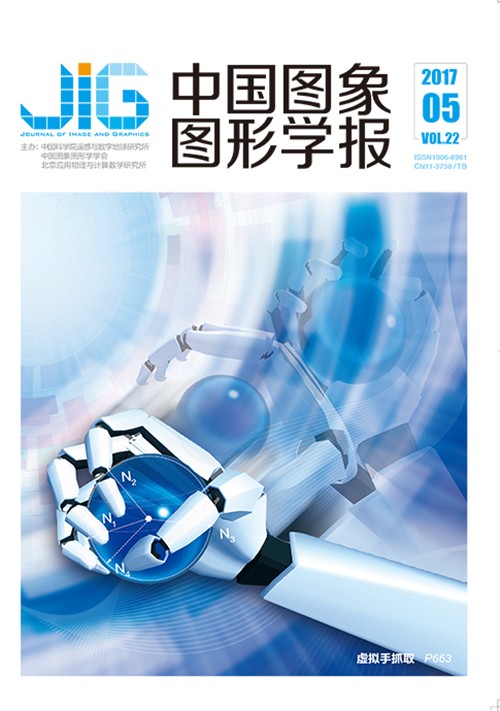
融合背景先验与中心先验的显著性目标检测
摘 要
目的 现有的显著性目标检测算法通常基于单一的先验信息,导致提取的原图像信息不全面,为了解决该问题,提出一种新的基于背景先验与中心先验相融合的显著目标检测算法。方法 该方法首先以边缘超像素为吸收节点,利用马尔可夫吸收链计算其他超像素的平均吸收时间作为背景先验值,得到背景先验图;然后使用改进Harris角点检测估计目标区域位置,建立峰值位于目标中心的2维高斯函数,计算各超像素的中心先验值,获取中心先验图;最后将背景先验图与中心先验图相融合得到显著图。同时该方法融合多尺度检测结果,进一步提高显著值的准确性。结果 通过ASD、SED1、SED2和SOD 4个公开数据库对比验证了基于背景先验与中心先验相融合算法具有较高的查准率、查全率和F-measure,相较于基于马尔可夫吸收链算法均提高了3%以上,总体效果明显优于目前的10种主流算法。结论 相较于基于单一先验信息的算法,基于背景先验与中心先验相融合的算法充分利用了图像信息,在突出全局对比的同时也保留了较多的局部信息,能高亮地凸显图像中的显著性目标。该方法在检测单一目标的图片时效果显著,但对于多目标的显著性检测尚有不足。
关键词
Salient region detection based on the integration of background-bias prior and center-bias prior
Zhou Shuaijun1,2, Ren Fuji2, Du Jun1, Yang Sai1(1.College of Electrical Engineering, Nantong University, Nantong 226019, China;2.Graduate School of Science and Technology, Tokushima University, Tokushima 7708506, Japan) Abstract
Objective Salient region detection based on prior has captured the attention of researchers in recent years. According to experience, the researchers assume that some regions are foreground or background and then detect salient objects based on these assumptions. However, the method based on single prior has a few weaknesses. For example, several classic methods based on center-bias prior always assume that objects are near the image center and disregard the objects that are far from the center. Methods based on background-bias prior take boundaries as background and calculate the saliency values of other regions according to their contrast with the background. Objects on boundaries cannot be highlighted. To solve these problems, a novel salient object detection algorithm based on the integration of center-bias prior and background-bias prior is proposed. Method First, the input image is divided into superpixels. Second, a graph is constructed with superpixels as nodes. Boundary nodes are selected as absorbing nodes, and the others are taken as transient nodes. The absorbed time from each transient node to boundary absorbing nodes is computed based on the absorbing Markov chain and taken as background-bias prior values. A single-scale background-bias prior map is obtained. Third, corner points of the input image are detected with a novel Harris corner detection algorithm. A two-dimensional Gaussian function with peak at the cluster center of corner points is constructed. The center-bias prior value of each superpixel is obtained through the Gaussian function. Fourth, the two prior maps are combined into the final saliency map. Results from multi-scale saliency maps are integrated to further improve the detection performance by different-scale superpixel segmentations. Result Extensive experiments of state-of-the-art methods and the method based on the integration of center-bias prior and background-bias prior are conducted on ASD, SED1, SED2, and SOD benchmark datasets. Experimental results show that the proposed method performs favorably against 10 state-of-the-art methods in terms of precision, recall, and F-measure. Compared with the method based on absorbing Markov chain, the evaluation metrics of the proposed method increased by at least 3%. Every method is also evaluated through the subjective approach. The result of the proposed method is the most excellent in detail and global aspects. Conclusion In contrast to the method based on a single prior, the proposed method based on the integration of center-bias prior and background-bias prior can extract more minute features of the input image. The saliency maps not only show global contrast but also have highly detailed information. The proposed method can highlight the salient object more effectively. Single object in images can be detected accurately because of the limitation of the center-bias prior. With regard to images with more than one object, the proposed method has some imperfections.
Keywords
|



 中国图象图形学报 │ 京ICP备05080539号-4 │ 本系统由
中国图象图形学报 │ 京ICP备05080539号-4 │ 本系统由